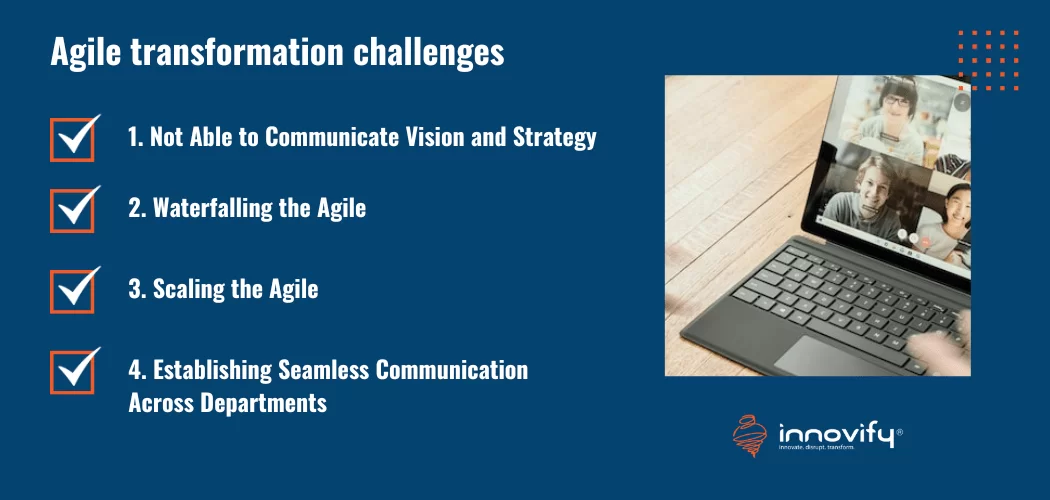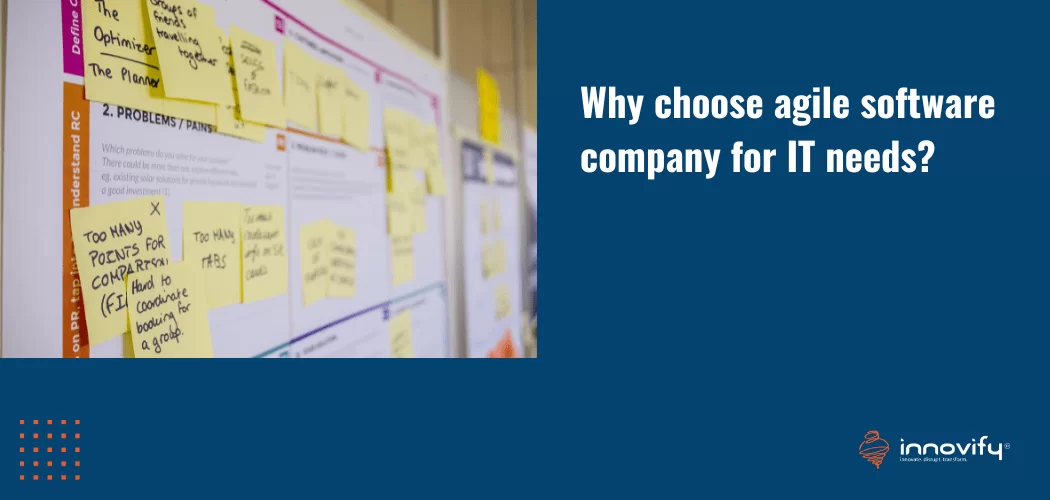AI/ML
9 Reasons to Use an Agile Software Company for Your IT Needs
The agile software development approach is a development methodology that encourages flexibility and applies practicality to the finished product.
In many organizations, agile software development requires a cultural shift because it focuses on delivering individual pieces or components of the software rather than the entire application.
For companies that don’t have the necessary IT infrastructure and innovation capability, Agile is not more than just a dream.
But how difficult is it to become agile?
4 Agile Transformation Challenges for Enterprises
According to VersionOne’s 13th Annual State of Agile Report, the proportion of businesses undertaking agile transformations is increasing, but not many of them succeed.
Only practicing agile to some extent is one of the most disastrous mistakes businesses make; it obstructs successful transformations.
Moreover, enterprises face a multitude of obstacles in their quest for success, while startups are confronted by comparatively few. Of course, some hurdles are impossible to overcome, but if enterprises know what to look for, there are common issues they may avoid.

Here are the most common challenges of agile transformation most enterprises face:
1. Not Able to Communicate Vision and Strategy
The agile transformation affects every aspect of an organization’s operating model and culture. Because of this, organizations need to ensure that leaders and C-level executives are aligned in their understanding of the values and goals of agile transformation before beginning the journey.
Unfortunately, many organizations lack this alignment. Instead of a common approach, many enterprises find executives hand-picking different approaches to agile transformation. It doesn’t end here; some leaders may resist the change altogether.
2. Waterfalling the Agile
It’s critical to keep in mind that agile values interactions over processes.
Organizations frequently obsess over implementing an agile framework into their operations, forgetting what agile is really about: minimizing processes and altering mindsets and behaviors to promote innovation.
Basically, without a proper strategy, the chances are high that the departments make agile a rigid process, which basically is the Waterfall.
3. Scaling the Agile
When embarking on an agile transformation, getting executive buy-in is critical. Many enterprises initiate the process by adopting agile practices in one vertical. They will begin with smaller teams and fewer leaders by applying agile techniques to a single department.
The outcome of a pilot project using this approach is usually favorable. However, its impact is usually limited.
Senior management usually finds it difficult to grasp the strategic significance of agile initiatives because they are so restrictive. Furthermore, they are unable to grasp the extensive ramifications of broader agile transformation efforts.
4. Establishing Seamless Communication Across Departments
Communication is a crucial element of agile.
However, when Agile principles are implemented across teams in an organization, communication issues between teams frequently impede the transformation process. Teams that lack communication may create problems.
Fortunately, all these agile adoption and transformation challenges can be easily resolved by partnering with an agile software company.
Let’s find out how.
How can Agile Software Company Help You Adopt Agile?

IT companies tend to be experts in software development. As they help multiple organizations with their IT needs, it’s imperative for them to adopt the best approaches to software development.
While agile is the most popular as well as customer-centric software development technique, some IT organizations like us have agile principles in their development process.
8 Reasons to Choose Agile Software Company for IT Needs

1. Faster Delivery of Software
An agile software company utilizes the Scrum approach to software development. Sprints (of usually 1-4 weeks) allow for scheduled software development.
An agile iterative approach results in the right thing at the right time, as each team develops software incrementally over short periods.
Design and testing are done simultaneously to shorten the entire product development cycle. Moreover, the time-to-delivery is lowered as a result of working software instead of lengthy documentation.
In an effort to deliver prioritized requirements, the overall delivery workflow is streamlined to quicken the product development cycle. Rather than lengthy documentation, working software is used to directly support this methodology.
2. Predictable Project Costs
Projects using the agile approach can be better and less costly because they allow less-important work to be dropped, and they, therefore, finish sooner.
Modern agile practices include test-driven-development and extensive automated testing, both of which are quality assurance measures.
Every moment wasted fixing bugs is a moment and a multitude of dollars wasted. Projects that employ agile methodologies do not squander as much time and money fixing errors as those that use traditional methodologies.
A short development cycle and frequent integrations both contribute to faster error detection, which again reduces the cost and time required to fix them.
3. Welcomes Changes
Principle #2 of agile is “welcoming the changes.”
When developing new features, agile software companies prefer staying flexible and responding to change rather than sticking to a rigid plan.
There is no point in building features that have lost their value, and agile software companies understand this.
On the other hand, if you believe that a new feature will help the business capture a strategic advantage, you should build it or at least investigate its feasibility, even if the original plan was incorrect.
An agile software company believes that they’re not delivering on the plan as originally envisioned—they’re delivering business value.
4. Transparency at Core
Since the beginning, everything is clearly defined in an agile approach, so everyone associated with the development is immediately aligned.
From development to deployment, developers and project owners can monitor everything and provide feedback on the application prior to and after each sprint to ensure all objectives are met.
Stakeholders and customers (You) receive daily updates and progress reports that keep everyone in the loop. The transparent processes allow for a controlled and supervised product development process. As a result, bottlenecks and project constraints are addressed as soon as possible to allow for smoother deliveries.
5. Quality Assurance
Using agile methodologies ensures quality. For every sprint, the code is debugged, errors are corrected, and efficiency is ensured.
To provide the highest quality product, an agile software company is wholly committed to Agile methodologies and keeps buffer time for improvisation. Every team member in an agile software development team is responsible for creating high-quality code.
When sprints are shorter, the team is more productive and responsive. Because of the multiple iterations, the team knows what works in every situation.
In addition, fast information flow and communication are among the core characteristics of agile, and they improve team performance and product quality.
6. Customer Satisfaction is Prime for an Agile Software Company
The Agile manifesto begins with a declaration that the company’s first concern is providing valuable software to customers as early as possible.
The manifesto states, “our highest priority is to satisfy our customers by delivering valuable software early and continuously.” The manifesto emphasizes that if the customer is not satisfied, regardless of how fantastic the code is, the project is not considered successful.
People are prioritized over procedures, including internal stakeholders and clients who will utilize the finished product or service.
An ideal agile software company ensures that every sprint release value and quality is continually enhanced with customer input.
7. Mitigates Project Faliure
The traditional approach to software development often results in a level of uncertainty that is not normally present. For example, in the traditional method, you may only perform product testing at the end of the project.
However, having to wait until the end of the project to perform testing could leave the team unsure if the product meets your demands.
Therefore, working on an Agile approach for your software development might lower the risk.
Every time the product is developed in a sprint, the agile software company will know whether they are on the right track. The team will then receive your feedback after every iteration. Every release will result in the creation of value if they do so correctly.
8. Gives You Better Control Over Project
Team members and clients (You) collaborate to determine exactly what is required for each iteration in Agile. Therefore, everyone on the team knows what must be completed.
Additionally, there is less possibility of unplanned features or surprises in each sprint, thanks to daily standup meetings.
During the retrospective meetings, everyone is informed about the project’s status. The team may quickly address problems in each phase because of this. The next sprint is prepared for during planning meetings.
Retrospectives permit the agile software company to learn from the previous phase and apply new strategies to improve future phases. In addition, quality is guaranteed throughout the project’s implementation phase, thanks to better control in agile development.
How Do You Find the Right Agile Software Company?

Alright, you’re convinced that agile is the best foot forward to software development, and partnering with an agile software company can bring you miracles. But how do you find the right company?
In your hunt for an agile software company, look for the following characteristics in your potential partner:
- Offers user-centered agile design
- Dedicated resources for DevOps
- Have continuous integration and delivery at the core
- Understanding of agile framework
- Have previous experience in agile development
If you’re looking for these traits in a software development company, then look no further.
By choosing an agile software development company like Innovify, businesses can benefit from a collaborative and flexible approach to development, enabling them to stay ahead of the competition and achieve their goals with confidence. With a focus on innovation and customer satisfaction, Innovify is the ideal partner for businesses looking to succeed in today’s fast-paced digital landscape.
Frequently Asked Questions (FAQs)
1. What does Agile mean in IT industry?
Agile is a software development methodology that emphasizes collaboration, flexibility, and rapid iteration. It involves breaking down a project into smaller, manageable pieces called sprints, with frequent feedback loops and continuous improvement.
2. Why is Agile important in IT industry?
Agile is important in the IT industry because it allows faster delivery of high-quality software products that meet customer needs. By focusing on collaboration and flexibility, Agile enables teams to adapt to changing requirements and market conditions, reducing the risk of project failure and maximizing the return on investment.
3. How can an agile company use it for its benefit?
An Agile company can use the methodology to its benefit by fostering a culture of continuous improvement and innovation. By embracing Agile principles, teams can collaborate more effectively, respond to customer needs more quickly, and deliver higher-quality products faster. Agile also enables companies to optimize their resources, reduce costs, and increase their competitive advantage in the market.




